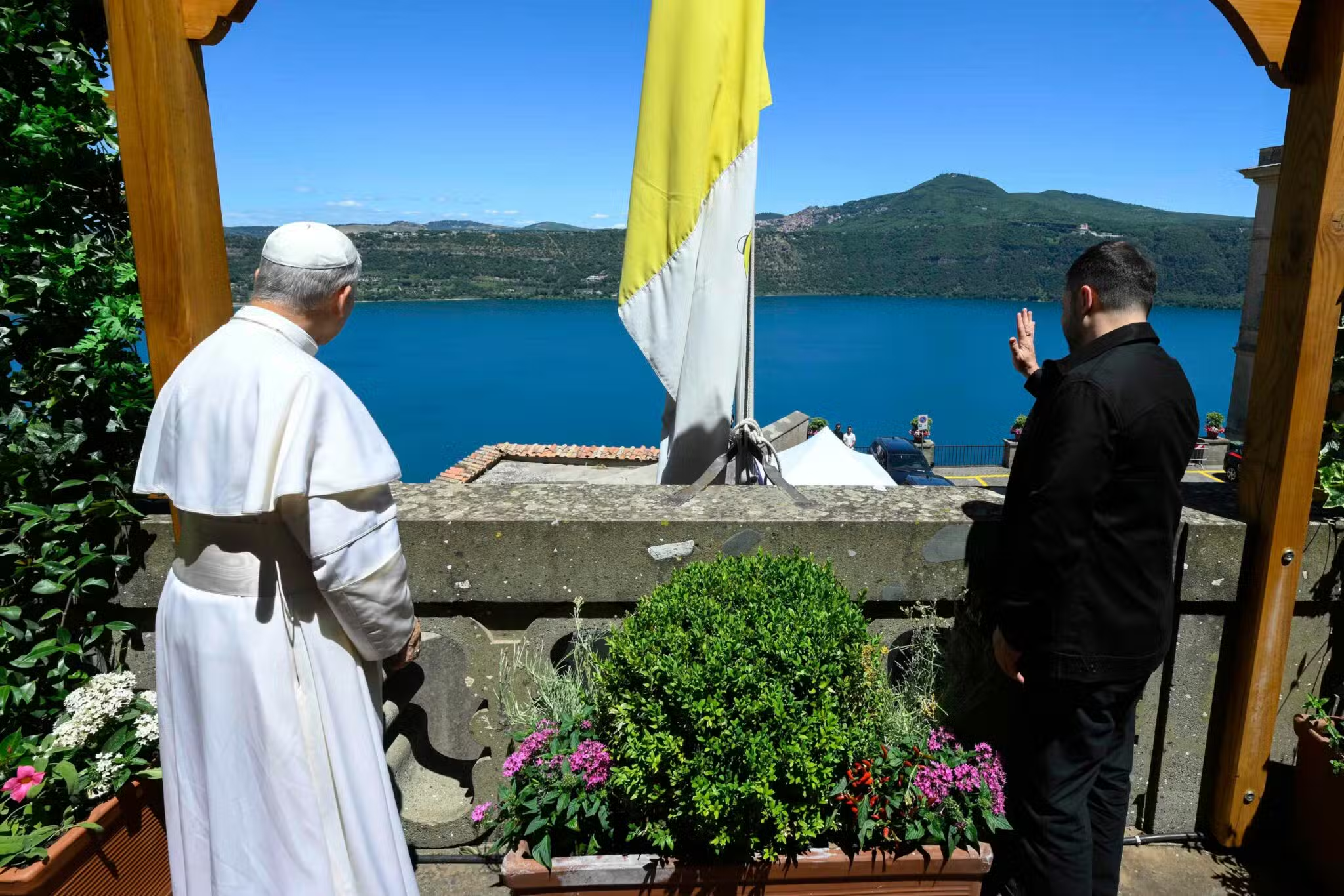Being Easter people means celebrating the good news of the risen Christ and opening our hearts and eyes to the signs of new life within and around us.
During the Easter season, I often ask workshop or retreat groups to name their own “small r” resurrections. I do so because it seems impossible to appreciate Jesus’ resurrection with a capital R without some grounding in our own experience.
Participants generate impressive lists: health after serious illness, a relationship transformed, a shaft of sun piercing a depressing day, a new venture late in life. One woman even described seeing the ultrasound of her new granddaughter two weeks after her husband’s death. Life and death brush hands in a mysterious dance, and sometimes we catch a heartening glimpse.
Such resurgence of life, bursts of energy, and banners of hope—are these not hints of the Resurrection? When Jesuit poet Gerard Manley Hopkins asks Christ to “Easter in us, be a dayspring to the dimness of us,” he captures this rooting of a lofty, hard-to-grasp doctrine in ordinary lives. The good news remains an unchanging, steady beacon, but the way we receive it is colored by our own experience. We may join half-heartedly in songs and celebration because we’re worried about the rent increase; it’s altogether different to sing full-throated alleluias because the biopsy was benign.
As we sow seeds this spring, it helps to notice how hard, small, and unpromising they look. Parents, grandparents, and teachers are sometimes blessed to see a seed they planted—skill with numbers, a commitment to justice, or talent for music—emerge in a later generation. But some people never see the seeds they plant blossom. In his book Taking Flight, Anthony de Mello tells the story of a woman who enters a store and finds God behind the counter. “What do you sell here?” she asks. “Everything your heart desires,” God replies. So she asks for peace, love, freedom from fear, and happiness for all humanity. God smiles: “I’m afraid you misunderstood. We don’t sell fruits here. Only seeds.”
Maybe the seed of the good news needs to lie fallow in us for a while, awaiting the right conditions to flourish. Maybe we need to tend the rich soil of grief, probing what we can learn from it. At such times, we pray that the tiny seed of hope may grow into the flowering tree of resurrection. If we look closely, we can probably see around us in nature a tangible symbol of hope. The laciest green fuzz appears on tree limbs. The blades of grass may be only one-eighth-inch high, but they soon will carpet the hillsides. No wonder a popular Easter song is “Now the Green Blade Rises.
The First Witnesses—and Us
Easter comes to us as fitfully as it did to the first disciples. We carry to the tombs of our lives the same mixture of doubt, fear, certainty, anxiety, and joy that the disciples brought to Jesus’ tomb. He always seems to choose for witnesses the most unlikely prospects, ourselves included.
Take Thomas, for instance. If Thomas—stubbornly insistent on tangible proof—can believe, maybe there’s hope for everyone. Doubt isn’t evil; it’s the entryway to hope.
For us as it was for Thomas, Jesus extends the same merciful invitation: “Touch me and see.” Where we might have expected glory and trumpets the first Sunday after Easter, instead the Gospel tells the story of honest, human groping toward truth. A sunny reunion between Jesus and his friends, who dazzle with their resilient faith? Not quite. But maybe something better: Jesus’ mercy, meeting them where they (and we) are, extending his hand toward Thomas in genuine understanding and compassion. Only by coming dangerously close to this wounded Lord will we, too, know transformation of our wounds—and resurrection.
In beautiful symmetry, the story of Jesus’ human sojourn on earth begins and ends with an angel bringing astonishing news to a woman named Mary. As Mary Magdalene waits outside the tomb, she discovers the boulder rolled away, the stunning emptiness within. Readers of John’s Gospel do not know her thoughts, only her posture. Why does she remain when Peter and the beloved disciple return home? Her persistence is clear: “But Mary stayed outside the tomb, weeping” (20:11).
Did she have a glimmer of hope, a faint suspicion based on her friendship with Jesus, that the story hadn’t quite ended? Did her intimacy with him suggest surprises still lay ahead, despite the limp, lifeless corpse, the heavy clunk of stone, the finality of soldiers sealing it? Did her curiosity trump her fear? Did she weep because she felt bereft and hopeless?
Or perhaps she was simply tired, too emotionally drained to think of the next step. When the future is unclear, it is wise to stay grounded in the present until a direction emerges. Maybe Mary was completely depleted, but she knew deeper down that the God who had been faithful before would be faithful again; God wouldn’t abandon her now. No matter how bleak the picture seemed, she waited with silent intention: focused, because she knew something would change. Her waiting led to surprise: She heard a familiar voice softly speak her name and ask gently why she wept. In the Gospel account of the Good Shepherd, Jesus calls his sheep by name (Jn 10:3); in this case he uses Aramaic, the familiar language of childhood, the instinctive language of prayer.
He comes to her as she is—disheveled, red-eyed, exhausted—not in some idealized, perfectly coiffed version. Jesus’ focus on Mary here is touching. He doesn’t rehash his own terrible ordeal or triumph in his Resurrection. He asks: “Whom do you seek? Why do you weep?” Those are good questions for reflection: Whom do we seek? Why do we weep? Often the first, easy answers aren’t true. If we respond, “Oh, I’m just fine, thank you very much!” we need to probe deeper. Maybe “fine” is the answer the culture expects; Jesus knows us better.
Beloved Sons and Daughters of God
When Mary Magdalene was blinded by sorrow, engulfed in grief, she was too numb to understand the full dimensions of what was happening, as we often are. But sometimes when we look back, we appreciate better. For instance, John 20:17 is the first time in the fourth Gospel that Jesus calls his disciples “brothers and sisters.”
When he refers to “my Father and your Father, to my God and your God,” he shows that he has accomplished the purpose of the Incarnation, stated in John’s prologue. Jesus’ becoming human made all people the children of God (1:12). Mary is puzzled because, initially, she looks for the historical Jesus she has always known, in a concrete, physical body. But her dramatic “turn” (Jn 20:16) means seeing him as the universal Christ, accessible everywhere and present within everyone.
She can no longer cling to the individual limited by time and space, fatigue and hunger, as all humans are. His new presence moves through doors, appears in two places simultaneously, and surpasses all the constraints of gender, nationality, or tribalism to become “Savior of the world.” Mary wasn’t completely wrong to think Jesus was the gardener (20:15), because now he has become every man and woman who ever lived or will ever live.
What does Mary’s “turn” mean for us? First, we must pivot from a narrow definition of Christ that limits him to Catholics who look like us, think like us, speak like us, believe like us, and agree with us. His mission is to everyone from the beginning of time, whether Buddhist, Hindu, Navajo, or Muslim. Could God ever exclude any of God’s beloved creatures from the best news ever: that they won’t die?
To put Mary’s experience into more common language: Do we ever realize what it is to be God’s daughter or son, eternally sharing God’s life? Probably no more than we fully appreciate the blessing of a beloved face, the startling clarity of blue sky, the warmth of a familiar voice or touch. If we begin with those tangible experiences, maybe we can take small steps toward the astounding news that what we never thought we’d have, we have. What we never thought we’d see, we see.
Stirrings of the Resurrection
How, then, do we live as Easter people? For starters, we can rewire our negativity, our fearful obsessions that threaten to blot out hope and smother life. Instead, attend to the prophetic message “as to a lamp shining in a dark place, until day dawns and the morning star rises in your hearts” (2 Pt 1:19). Of course, we have reasons that tempt us to despair. But we have even better ones to build hope on Christ’s promise. Whatever evils this life contains, they don’t have a permanent hold on God’s beloved.
Despite the brutality and outrage of the Crucifixion, the disciples were held in a deeper love. Fearfully, they relied on locked doors, a natural instinct. On the road to Emmaus, however, Jesus converses with the disciples who “stopped, looking downcast” (Lk 24:17). He gets them moving again, having them recount the events of the past three days. Then he shows them how those events are only one part of a larger story. He also asks us: What could hover beyond the fear? If we are Easter people as we name ourselves, we can become more comfortable with our questions, more open-ended in our waiting.
As Brother David Steindl-Rast points out in Gratefulness, the Heart of Prayer, the angel’s message to the bewildered disciples doesn’t say that Jesus has come back to life. Our concept of life always ends with death. But Jesus has already passed through and transformed that portal. “He is not here” means that Jesus has gone far beyond our limited understanding. All we know is that “the tomb is open and empty, a fitting image for wide-open hope,” writes Brother David.
For years after her meeting in the garden, Mary Magdalene must have cherished the tender tones of a beloved voice calling her name. All the women must have held in their hearts the words, “He is not here but has risen.” What words do we cherish?
At some time, we must have received news or an assurance we thought we didn’t deserve. The person we loved from afar loves us too; the harvest has been spectacular; despite many setbacks, the children have turned out splendidly; the health scare was groundless. Or even: The health scare was genuine, but we’ve come to peace with it. This is the season to savor our personal good news, our entryway to the stunning news that we will live forever.
We can also delight in stirrings of resurrection within, signals of our inner growth. Sometimes we’ll say in surprise, “I handled that difficult conversation rather well!” or, “I didn’t get tripped up, depressed, or unhinged by that situation that has always bugged me.” Insert personal triumphs here: “I turned that rocky patch into a garden.” “I’m learning to say no more gracefully, or assert myself, or keep a lid on the anger.” “I’ve been building in quiet time for reflection every day.” They may seem like small signals, but all form stepping-stones to resurrected life, even here, even now.









1 thought on “Everyday Resurrections: A Meditation on Easter”
Love the quiet introspection you encourage.